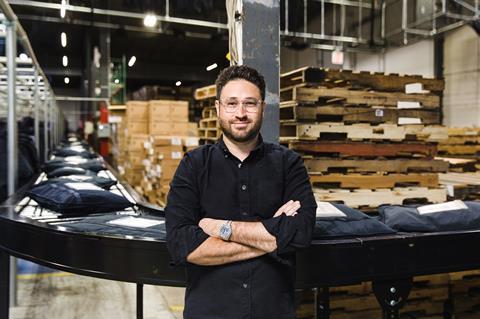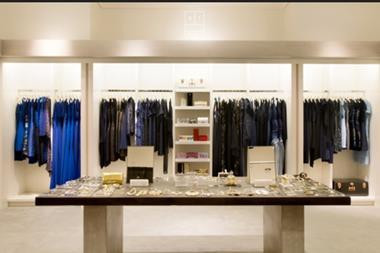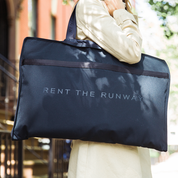“We are not an ecommerce business – it sounds like a soundbite, but it’s true.”
It’s a bold claim by Rent the Runway’s chief technology officer and head of product Josh Builder, given that he works for a business whose primary purpose is helping women beef up their wardrobes, but it is an assertion he is confident he can back up.
When discussing one of the perennial problems facing online retailers today, Builder points to a crucial difference between his platform and theirs: “We have a 100% returns rate on our inventory and it is a vital component of our business model.”
“A big part of my job is making the complexity of our business as simple as possible for our customers”
Josh Builder, Rent the Runway
Builder argues that because Rent the Runway’s operating model depends on its customers returning all of their purchases, and shoppers pay for access to the platform’s ‘closet in the cloud’, rather than to own the stock themselves, the platform is not an ecommerce platform in the traditional sense of the word, but a subscription service.
Builder joined the clothing subscription specialist in 2016 after stints running the technology divisions of businesses including exercise class cum life-coach phenomenon SoulCycle and music label The Orchard, which went on to be sold to Sony Music.
It’s not a typical career trajectory for the tech boss of a clothing business – but then, Rent the Runway is not a typical business.
Hire calling
Since being founded a decade ago, Rent the Runway has operated on the premise of giving professional women the option to hire clothing from a variety of designer labels they might not otherwise be able to afford.
It offers a variety of price points for its membership schemes, ranging from $89 per month to rent up to four items on a monthly rotation, to $159 to rent an unlimited number of clothing items from Rent the Runway’s pool of more than 650 brands, whenever customers want, for as long as they want.
The combination of high-end clothing from so many brands at a fraction of the cost of buying outright, alongside the sustainability kudos of reusing items that may otherwise have ended up languishing at the back of a shopper’s closet or festering in landfill, has proved a heady combination for customers, retailers and investors alike.

Rent the Runway hit the $1bn (£805m) valuation milestone this year after winning high-profile backers, including Alibaba founders Jack Ma and Joe Tsai’s investment firm Blue Pool Capital, Franklin Templeton Investments and Bain Capital Ventures.
Rent the Runway’s stratospheric rise has made retailers sit up and take notice. This year big names ranging from Bloomingdale’s to Urban Outfitters have unveiled plans to launch their own clothing subscription models, and Rent the Runway itself has teamed up with upmarket US department store Nordstrom, allowing shoppers to pick up and return their goods from Nordstrom Local branches.
Builder defines his roles as having two main elements – first, to oversee the development and deployment of technology across Rent the Runway’s supply chain and logistics arm; and second, to steer the technology underpinning the website, stores and app.
“A big part of my job is making the complexity of our business as simple as possible for our customers,” he explains.
“We try to bring more and more flexibility to our customers, and more and more ways of interacting with us, so one of the key challenges over the next few years is how to expand our flexibility and do it at scale.
“We want to create a subscription that enables our customers to do what they want with us on their terms so that, as our customers change, we change with them – even in terms of the types of things they want to rent.”
To that end, Rent the Runway unveiled a partnership with West Elm Company this year that allows members to rent homewares ‘bundles’ of three or four items, in the same way they do with an item of clothing.
The history of Rent the Runway
The rental subscription business was born in 2009 by chief executive Jennifer Hyman and Jenny Fleiss, who met at Harvard Business School.
Inspiration for the business came after a eureka moment for Hyman, whose younger sister had just splurged on a $2,000 designer dress for a wedding and gone into the red on her credit card as a result.
Rent the Runway was founded as an antidote to this, by giving customers access to sought-after designer labels without the eyewatering price point of buying them outright. Rent the Runway allows its members to pay a monthly subscription fee to access a revolving selection of designer-clothing items, which they can keep as long as they like, or a one-off fee to rent specific garments for a four- or eight-day period.
Once a customer is done with an item of clothing, they return it to Rent the Runway via post, one of its five stores or one of its designated drop-off points at selected Nordstroms and WeWorks.
Orders that are returned to Rent the Runway’s warehouse are dry-cleaned and undergo repairs if necessary before being sent to the next customer.
Today, the business stocks 650 brands, has 1,800 employees and has reached 11 million members to date, according to CNBC.
It’s positioned in a rapidly growing section of market, with the clothing rental market currently valued at $1.3bn (£1bn) by GlobalData – a number that’s forecast to rise to $4.4bn (£3.5bn) by 2028.
Rent the Runway co-founder and chief executive Jennifer Hyman says her long-term ambition is for the business to become “the Amazon Prime of rental”, so further forays into sectors outside of fashion are likely to follow in the coming years.
It is for this reason that Builder says the business is reaping the rewards of building its warehouse management systems in-house.
“It’s a good question: why would anyone go about building a warehouse management system for themselves from scratch? It’s painful, and those things already exist,” he laughs.
“But we are not an ecommerce business – we are not selling stuff that sits on a shelf, goes out, and that we don’t expect to come back. Things are always coming back to us, and when you are in that kind of relationship with your customers, it breaks the law of gravity around how traditional warehouse management works.”
“The aim is for it to become as fun and seamless as browsing Instagram”
Josh Builder, Rent the Runway
The unique structure means that, as of 2015, 60% of the inventory that was returned to Rent the Runway’s inaugural warehouse in New Jersey was sent back out to the next customer the same day, having been dry-cleaned, steamed and had the speed of its redeployment determined by computer forecasting based on the demand for a particular item.
At that time, Rent the Runway items were worn by 30 different customers, thanks in large part to dry-cleaning and repair teams that operate within the platform’s warehouses alongside its order-fulfilment systems.
While Rent the Runway made the decision to develop it own warehouse management systems in-house early on out of necessity, today it is a “major asset”. That is because it provides “ultimate control” over how quickly the company innovates, whether on delivery speed or the types of products it processes – and will process in the future, as it expands into other product categories – through its fulfilment centres.
A second distribution facility in Dallas, Texas, will help towards the goal to offer a “consistent” delivery experience for members, regardless of where in the US they live.
Closing the clothing data loop
Another focus for Builder is to offer customers a consistent product-quality experience, although he believes that Rent the Runway’s business model gives it the edge over traditional retailers in this regard.
“For the history of ecommerce or even commerce in general, when somebody sells you something they have data about who manufactured it and who ordered it and then they never know anything about that product again,” he says.
“But our operating model means our customers are in a constant relationship with us. We have this immense opportunity, from the moment somebody has [received] something to what their experience with it was. Did it fit, was it tight on the arms, how did it make them feel, where did they wear it and would they wear it again?
“We also get explicit data, like whether a zipper always breaks or does it always rip on one shoulder, and we can use that data to learn really interesting things about fit and fabric, which means our designers can build a dialogue about how a product actually performed in the real world.”
Builder says Rent the Runway has used its data on sizing to give customers peace of mind when browsing. When a user signs up, they are asked to enter their measurements and are then presented with products that have been worn and given good feedback by shoppers with similar physiques.
Any one-off rental item that a user pays for will also be sent to her in two different sizes as standard, and at no additional cost.
“Our shoppers cannot share enough data with us and they want to do it, so we try and use that to our advantage where we can,” he explains.
Builder is also responsible for the evolution of Rent the Runway’s website and app. The latter, Builder says, has pivoted away from copycatting a traditional retail website in its infancy to become more of a community and content-led Instagram-style layout in recent years.
“Back when our average customer rented from us two or three times a year, it was really important that we created an online experience that they could understand. But now that we are getting them dressed 120 times a year, that interaction is completely different,” he says.
“It’s evolving away from shopping to feeling like you are part of a community and we are trying to guide shoppers to things they would like more. The aim is for it to become as fun and seamless as browsing Instagram, and less like shopping. People actually don’t want to go shopping and scroll through pages and pages of products any more, so it’s about trying to evolve to meet the customer where they are.”
Rent the Runway is redefining fashion spending and its ambitions beyond fashion should put it on the radar of all in retail.
With plans to hire 150 engineers and developers at its newly opened European headquarters in Galway, Republic of Ireland, over the next three years, the rental platform could be meeting UK shoppers ’where they are’ sooner rather than later.
Tech. 2019
Josh Builder is one of the keynote speakers at this year’s Tech. festival.
He will be speaking about how Rent the Runway has disrupted its customers’ shopping and monopolised on the sharing economy, as well as how it will develop its proprietary data and inventory technology for the future.
To see who else is on the packed programme and reserve your place and the festival, visit tech-festival.com.


























No comments yet